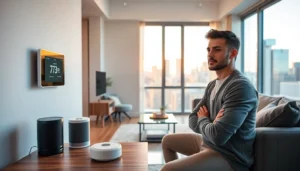Table of Contents
ToggleImagine waking up to your coffee brewing, lights gently illuminating your path, and your favorite tunes playing—all without lifting a finger. Welcome to the world of smart home design, where technology meets comfort in the most delightful ways. It’s not just about convenience; it’s about transforming everyday living into a seamless experience that makes life easier and a lot more fun.
Smart home design isn’t just for tech enthusiasts or those with deep pockets. It’s for anyone who appreciates a little luxury in their daily routine. From energy efficiency to enhanced security, the benefits are as appealing as a freshly baked pie on a Sunday afternoon. So why settle for a house that just houses you when you can have a home that thinks for you? Dive into the world of smart home design and discover how to turn your living space into a futuristic haven.
Overview of Smart Home Design
Smart home design integrates technology into living spaces, elevating both convenience and comfort. With accessible features, this design approach suits various lifestyles and budgets.
Definition and Importance
Smart home design refers to the incorporation of advanced technology into residential environments. This design enhances daily routines by automating tasks and monitoring systems. It holds significant importance as it promotes energy efficiency, which can lead to cost savings. Improved security also plays a vital role, allowing homeowners to monitor their properties remotely. By accommodating various needs, smart home design fosters a more personalized living experience.
Key Features of Smart Homes
Key features of smart homes include automated lighting, which can be controlled from smartphones. Smart thermostats adjust temperatures based on user preferences, promoting energy conservation. Home security systems often incorporate cameras that allow real-time monitoring. Smart appliances, such as refrigerators and ovens, enhance convenience with remote access and controls. Voice-activated assistants streamline various tasks, making everyday life easier.
Benefits of Smart Home Design

Smart home design offers numerous advantages that significantly enhance daily living. Individuals can enjoy improved quality of life through smarter environments that promote efficiency and safety.
Convenience and Comfort
Automated systems streamline everyday tasks, making life easier. Homes equipped with smart technology allow people to control lighting, climate, and security with simple commands. Voice-activated assistants provide effortless interaction for managing schedules and reminders. Automated lighting adjusts based on occupancy, enhancing comfort and saving energy. Smart appliances make routine chores more manageable, from washing dishes to cooking meals, ensuring a seamless living experience.
Energy Efficiency
Enhanced energy efficiency represents a core benefit of smart home design. Smart thermostats adapt to occupants’ habits, reducing heating and cooling costs by up to 20%. Energy-efficient smart lighting uses LEDs and schedules to minimize wastage. Home security systems help identify energy leaks by monitoring usage patterns, encouraging faster reactions to inefficiencies. By using energy consumption data, homeowners can make informed decisions to lower bills and reduce environmental impact.
Essential Components of Smart Home Design
Smart home design incorporates various components that enhance functionality and convenience. Three key aspects include smart lighting, smart security systems, and smart thermostats.
Smart Lighting
Smart lighting solutions provide flexibility in managing indoor and outdoor illumination. Users can control brightness and color remotely through mobile apps, creating desired atmospheres for different occasions. Energy-efficient LED bulbs often feature scheduling options, allowing lights to turn off when not needed. Integration with voice assistants simplifies access, providing hands-free control. Automated systems can adjust lighting based on natural light levels, promoting energy savings.
Smart Security Systems
Smart security systems ensure residential safety through advanced technology. Homeowners can monitor properties in real-time through security cameras, receiving alerts for unusual activities. Integration with door sensors enhances security by notifying users when doors open or close unexpectedly. Remote access to security features allows users to lock doors or adjust cameras from anywhere. Additionally, smart systems can connect to emergency services, providing rapid responses when needed.
Smart Thermostats
Smart thermostats optimize home heating and cooling systems efficiently. Users can program settings for energy savings based on their daily routines. Remote control features grant access to adjust temperatures via smartphone apps from any location. Some models utilize learning algorithms, adapting to users’ preferences automatically over time. Energy usage reports encourage informed decisions, helping homeowners track consumption and reduce utility bills effectively.
Challenges in Smart Home Design
Designing a smart home involves various challenges that can complicate the user experience. Addressing these issues is crucial for an effective implementation.
Integration Issues
Integration issues often arise when trying to connect multiple smart devices from different manufacturers. Compatibility between devices can be problematic, leading to functionality gaps. Users may experience difficulty in managing various applications for controlling their devices. Inconsistent interfaces can hinder ease of use. A lack of standardization in smart home technology further complicates integration, making it essential for manufacturers to collaborate on common protocols. Prioritizing devices that support interoperability can ease this transition, ensuring cohesive operation.
Privacy and Security Concerns
Privacy and security concerns remain top priorities for smart home users. Cybersecurity threats can pose risks, exposing sensitive data through compromised devices. Poorly secured systems can allow unauthorized access, leading to breaches that compromise personal information. Consumers often hesitate to adopt smart home technology due to fears regarding data misuse. Ensuring robust encryption methods and user privacy controls is vital for mitigating these risks. Manufacturers must prioritize the implementation of security features, giving users peace of mind while enjoying the benefits of a connected home.
Future Trends in Smart Home Design
Emerging technologies are shaping the landscape of smart home design, paving the way for more intuitive and sustainable living environments. Notable trends include the rise of AI and automation alongside an increased focus on sustainability.
AI and Automation
AI is becoming integral to smart home function. This technology analyzes user patterns, adjusting settings automatically based on learned preferences. Homeowners experience greater convenience with voice-activated assistants managing everything from lighting to temperature. Additionally, automated systems enhance security, detecting unusual activity and alerting users in real time. The seamless integration of AI leads to a smoother user experience and reduced daily tasks.
Sustainable Solutions
Sustainability in smart home design emphasizes eco-friendly technologies. Smart devices optimize energy usage, significantly lowering utility costs and environmental impact. Energy-efficient lighting and smart thermostats reduce waste by adapting to user schedules. Moreover, solar panel integration allows homes to generate renewable energy, further decreasing reliance on non-renewable sources. As homeowners prioritize sustainability, these innovations contribute to greener living, encouraging widespread adoption of smart solutions.
Smart home design represents a significant shift in how people interact with their living spaces. By embracing technology that simplifies daily tasks and enhances comfort, homeowners can create environments that cater to their unique needs. The integration of smart devices not only promotes energy efficiency but also prioritizes safety and convenience.
As technology continues to evolve, the future of smart homes looks promising. With advancements in AI and automation, these systems will become even more intuitive and user-friendly. Homeowners who invest in smart home solutions today will enjoy the benefits of a more efficient and sustainable lifestyle tomorrow. Embracing this trend is not just about convenience; it’s about creating a better quality of life.






